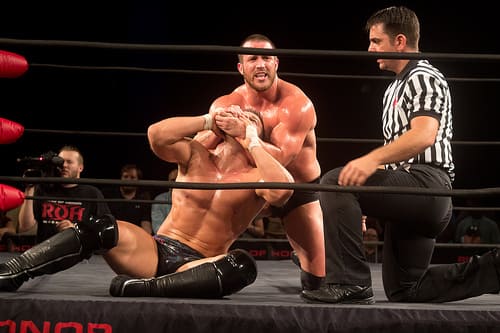

I used to be a big wrestling fan when I was younger. Many Monday nights my brother and I would join my Dad and uncles in a weekly ritual of watching WWF (now WWE) programming. Wrestlers like The Rock, Stone Cold Steve Austin, and Shawn Michaels would duke it out in the squared circle and talk trash like nobody’s business. As a kid, I’d eat it up. It was the real life equivalent of a comic book.: ripped and muscled dudes wearing spandex fighting each other.
Then I grew up and realized it was all fake.
The matches were had predetermined outcomes and the trash talking was all scripted. But even as a young adult, I still watched it. And clearly, millions of people around the world still watch it even though most know it’s fake. Why?
Because pro wrestling taps into something people love: good versus evil stories.
There’s always a feud between two wrestlers: the face and the heel. The face is usually the underdog, goody two-shoes everyone is rooting for while the the hell is the penultimate villain. For weeks, the shows build on the feud through scripted interactions or physical bouts. The face usually gets beat up multiple times and taunted by the heel. He’s at the mercy of his nemesis constantly, never tasting victory until the obligatory Sunday pay-per-view match. During that match, the face finally gets justice. The heel is defeated and humiliated, and wrestling fans everywhere rejoice in raucous applause.
Then when the Monday show rolls around, the cycle begins anew. A new face, a new heel, and a new feud.
How does this relate to creative writing?
It relates because of the significance of story.
Stories need heroes, villains, and conflict to captivate people. It seems like such a basic thing, but you’d be surprised how often writers get this wrong. Sometimes writers focus only on creating deep, engaging characters, but neglect the conflict of the story. Who cares if you have amazing characters if there’s no conflict? That’s not a story, it’s a character study. Same goes with neglecting characters for the sake of a fanciful plot. The last thing readers want are wooden characters they can’t empathize or relate with.
That’s why storytelling is a very delicate balancing act. The individual parts create the whole. But if I had to emphasize one aspect more than all others, I’d say it’s conflict. In wrestling, the building conflict between the face and the heel keeps viewers tuning in every week and glued to their seats. The same goes for fiction. It’s your job as the writer to raise the stakes and make your characters’ lives increasingly complicated.
The heroine loses her keys before her big date. The hero finds out the villain is his father. The villain kills the love interest of the hero. And so on. If conflicts in a story don’t progressively build, then it stalls and your readers lose interest. Believe me, that’s the worst thing to happen to an author–bored readers.
So take a page out of pro-wrestling and keep the conflict interesting by holding your characters’ feet to the fire at every turn. You’ll be a better storyteller by doing so.


